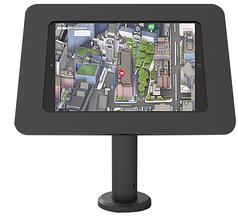The following is a recent snapshot of an interview with Concept3D’s own Brian Rehkopf, Senior Account Executive, Healthcare, about the advances and trends in digital wayfinding for hospitals.
Brian works closely with hospitals and healthcare campuses to meet their specific needs in providing patients, visitors and staff with the best possible experience.

Brian Rehkopf: “One of the biggest issues for digital wayfinding systems nowadays is cell service. Hospitals are unique in that they are large, complex campuses with seemingly endless interior hallways and rooms. In these hallways, cell service can be spotty, resulting in limited service which skews many wayfinding applications.”
What are some of the latest trends and advances in digital wayfinding for hospitals?
BR:
- “Digital wall signage is becoming more popular, as many visitors to a campus will not think to (or want to) download an app or open a webpage on their smartphone or mobile device. Digital wall signage ensures that guests can be reached without having to download or open anything.
- Digital wayfinding kiosks – A trend around kiosks is to ensure that there is a reload function that automatically refreshes the display. That way, you can ensure that a fresh experience is ready for every guest.
- Hand-held/mobile digital wayfinding – The latest advances use Bluetooth beacons to ensure that connectivity, as mentioned above, stays strong no matter where you are.”

What digital signage/wayfinding product has Concept3D recently introduced to the healthcare market?
BR: “Concept3D recently released an exterior-to-interior wayfinding engine for the healthcare market. This product picks up where traditional wayfinding engines leave off, delivering a complete experience all the way from someone’s home or starting location to their final destination, even if that destination is a small room, inside a huge building, on the third floor. This wayfinding is completely customizable, which means that Concept3D clients can control and optimize routes. This is crucial as hospitals have so many areas with select access, and routes can be made to guide people around those.”
How can geolocation and real-time location services (RTLS) be used for hospital wayfinding?
BR: “Geo-location and real time-location services will play an important wayfinding role for hospitals and health campuses, but the accuracy of these services is still a challenge. As wearable devices become more and more common – like the Apple Watch with haptic direction indicators – there’s a lot that can be done to help people find their way around. However, I anticipate that even with greater use of geo-location and RTLS, digital wayfinding kiosks will remain an important and useful tool for hospitals as part of a complete wayfinding solution.”
What unique challenges do small, off-campus healthcare facilities have for digital wayfinding?
BR: “It’s difficult for wayfinding providers to connect the small, offsite locations to the larger, main campus. Many wayfinding providers are based on a static, closed environment, which means that offsite locations dramatically increase the challenge of accounting for these offsite locations. The Concept3D platform is unique in the fact that it uses a world map, OpenStreetMap, which allows our platform to feature any buildings – interiors and exteriors – that a client wants to include.”
How important is data collection in digital wayfinding, and how can that data be used?
BR: “Data collection is vital to maximize the potential of your wayfinding engine. Knowing how people use it, when, why, and to what extent allows our clients to customize the experience for the user. Data – like the most popular locations and search results – can help hospitals and health campuses know which areas they need to improve other aspects of wayfinding and general mass people movement such as physical signs, highlighting the fastest ways in and out of a building, and floor plan layouts.”
What future advances do you see in digital signage/wayfinding systems for healthcare facilities?
BR: “The big advance I see for digital signage/wayfinding systems for healthcare is the ability to easily guide visitors to an online platform. A challenge I keep hearing is directing physical visitors to the digital wayfinding service. As it stands, there is no way to do this without either downloading an app, opening a web page, or reading a QRcode. All these options are time consuming and create an obstacle for the guest. We’ll see a lot of integration in the next couple of years as hospitals and healthcare campuses look for a core system able to drive the majority of their wayfinding needs.”

